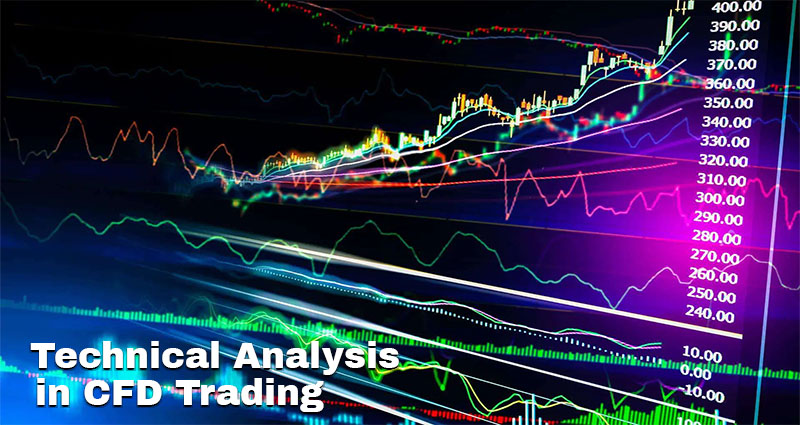Are you a CFD trader looking to get ahead of the game and improve your trading performance? Then mastering technical analysis is an absolute must. Technical Analysis in CFD Trading: A Comprehensive Guide is filled with actionable strategies for maximising opportunities and minimising risk in Contract for Difference (CFD) trading using technical analysis.
This guide will teach us how to identify potential entry points, manage our positions more effectively, interpret market sentiment through charts or indicators, and ultimately become better investors. We’ll also cover professional tips from expert traders that can help catapult your success beyond other investors in the market. So, let’s learn how gainful technical analysis in CFD trading can help us achieve our financial goals.
What is Technical Analysis in CFD Trading and How Does it Work?
CFD trading is an exciting way to invest in the markets using leverage. However, any investment requires a sound trading strategy to succeed. This is where Technical Analysis comes in. Technical analysis is a method of analysing past market data, primarily through charts, to predict future market trends. By examining price movements, volume, and other indicators, traders can identify critical levels of support and resistance and potential entry and exit points for trades.
Technical analysis is used by traders across various financial markets, including CFD trading, and is considered a valuable tool for making informed trading decisions. Whether you are a seasoned trader or just starting, incorporating Technical Analysis into your CFD trading strategy can help you stay ahead.
Identifying Support and Resistance Levels
Support and resistance levels are key areas on a chart where price movements reverse or slow down significantly. By recognising these levels, traders can make better decisions with their entry and exit points in the CFD market. Two types of support and resistance levels exist horizontal lines and trendlines.
Horizontal lines represent static support and resistance levels, while trendlines are dynamic lines that show the direction of a trend. To identify these levels, traders should look for patterns in the chart, such as double tops and bottoms or price channels, which can help to indicate support and resistance levels.
In addition to identifying levels of support and resistance, traders should be aware of other critical elements on a chart, such as volume indicators, pivot points, and time frames, which can also help to determine potential entry and exit points.
Types of Market Indicators for Technical Analysis
When it comes to Technical Analysis, a range of market indicators can be used to interpret price movements. Popular indicators include Moving Averages (MA), Relative Strength Index (RSI), and Bollinger Bands (BB).
The Moving Average indicator tracks the average price over a specified period and helps to identify trends. The RSI is an oscillator that measures momentum and helps to identify possible overbought or oversold conditions in the market. Bollinger Bands measure volatility and help to indicate when a trend may be reversing. By combining these indicators with support and resistance levels, traders can form more precise entry and exit points for their trades.
Using Charts to Analyse Trends in the Market
Charts are an essential tool for analysing market trends. By examining the chart, traders can identify potential entry and exit points and support and resistance levels. They should also be aware of patterns in the chart which may indicate a trend reversal or continuation. Chart analysis is not limited to price movements; traders should also pay attention to volume indicators such as trading volume and open interest, which can be used to gauge market sentiment.
Finally, traders should also consider the time frame they are trading in, as this will affect their overall strategy. Shorter-term charts may be more suited to scalping strategies, while longer-term charts are better for swing or position trading. By using these techniques, traders can better understand the markets and make more informed trade decisions.
Understanding Price Patterns in CFD Trading
Price patterns are vital for traders to consider when conducting Technical Analysis. By identifying common patterns such as double tops and bottoms, head and shoulders, or triangles, traders can gain insight into potential market trends and make better-informed decisions with their trades.
In addition to price patterns, traders should be aware of other chart signals, such as candlestick analysis and chart patterns, which can provide valuable information on potential entry and exit points. By combining all these strategies, traders can develop a comprehensive trading plan that can increase the probability of market success.
Combining Different Technical Analysis Tools
It is important to remember that while Technical Analysis can be an effective tool for trading CFDs, it should not be the only factor considered when making investment decisions. By combining various tools such as chart analysis, market indicators and price patterns with fundamental analysis, traders can gain a more comprehensive understanding of the markets and make more informed trades.
Ultimately, the aim is to use these tools in conjunction with each other to potentially maximise profitability. By staying updated with market news and keeping an eye on critical levels of support and resistance, traders can get closer to developing a winning strategy to help them achieve their financial goals.











